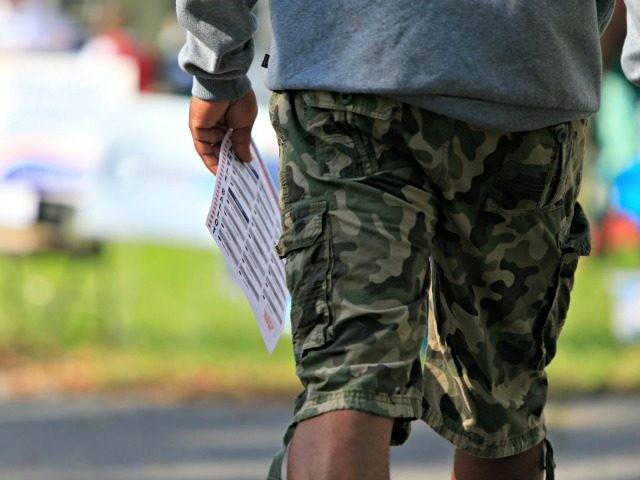Absentee ballots cast in North Carolina, a category that includes in-person early voting and mail-in voting, already exceeds the total number of absentee ballots cast in 2016 with five days to go until in person early voting ends on Saturday.
Mail-in absentee ballots will continue to be counted so long as they are postmarked by election day, Tuesday, November 3. Until current litigation is resolved, it is unclear how many days after the election mail-in ballots postmarked by November 3 will be received by election officials and included in the final vote counts.
The Charlotte News & Observer reported:
About 3.17 million absentee ballots had been cast in North Carolina as of Sunday, nine days before Election Day, records show. The number will continue to climb as early-voting sites remain open this week and mail-in ballots continue to roll in.
In 2016, a total of about 3.14 million North Carolinians used absentee voting.
“We’ve never seen numbers of this magnitude, ever, in North Carolina,” said Michael Bitzer, a political science professor at Catawba College in Salisbury and one of the state’s leading political experts.
A number of political analysts have speculated that health concerns over the coronavirus pandemic will result in a significantly greater percentage of early votes cast in the 2020 election–either in person or by mail–than was the case in 2016.
Reports of high early voting in North Carolina and many other states suggests that may well be the case in 2020.
It remains to be seen if that anticipated higher early voter turnout will result in a greater overall voter turnout, or will merely shift the timing of votes from election day to early voting.
Donald Trump defeated Hillary Clinton in 2016 by 3.7 points in North Carolina, with 49.8 percent of the vote to Clinton’s 46.1 percent out of a total of 4.7 million votes cast, which was 69 percent of the state’s 6.9 million registered voters, a voter turnout rate that was surpassed by five states that had more than a 70 percent turnout rate: Colorado, Maine, Minnesota, New Hampshire, and Oregon.
Of those who voted in the state, only about 33 percent (1.54 million) voted on election day, while 67 percent (3.16 million) early voted, either by in person, absentee ballot, or vote by mail.
“In the 2016 election, early voting made up more than 60 percent of the total votes cast in Arizona, Florida, Montana, North Carolina, Nevada, Oregon, and Texas,” the U.S. Election Administration Commision’s (USEAC) Election Administration and Voting Survey, 2016 Comprehensive Survey reported.
Though she lost the presidency, receiving 227 electoral college votes to Donald Trump’s 304 (with seven faithless electors), Clinton won the national popular vote in the 2016 presidential election, with 48 percent of the 140 million votes cast. Donald Trump received 46 percent of the popular vote.
Nationally, 63 percent of the country’s 214 million registered voters cast their ballots. Of those who voted across the country, 59 percent voted on election day while 41 percent early voted, either in-person (17 percent) or by mail-in absentee ballot (24 percent), according to the USEAC.
The USEAC noted that, in the 2016 presidential election, “By mail absentee voting rates vary dramatically across states. Nationally, 79.9 percent of absentee ballots transmitted to absentee voters were returned and 99 percent of returned ballots were counted.”
The Real Clear Politics Average of Polls currently gives Democratic challenger Joe Biden a 0.8 point lead over President Trump in North Carolina, a state whose 15 electoral college votes helped the president reach his 304 electoral college total in 2016, 34 more electoral college votes more than the 270 needed to win the presidency.
With one week until election day, and great uncertainty over the reliability of 2020 polls conducted by a number of firms that were so far off in their electoral college polling projections in 2016, some analysts are looking at early voting data for possible indications of the outcome of the presidential election.
North Carolina is one state where voters identify whether they are Republican or Democrat when they cast their ballot.
In North Carolina’s 2016 early voting counts, 9.9 percent more Democrats than Republicans early voted.
So far in 2020 early voting counts, 9.3 percent more Democrats than Republicans early voted in the state.
As of Tuesday, 39.8 percent of the 3.4 million early votes cast in North Carolina were from Democrats, while 30.5 percent were from Republicans, the U.S. Election Project reported.
Currently, there are seven million registered voters in North Carolina. If total turnout in 2020 is the same 69 percent it was in 2016, a total of 4.8 million ballots will be cast in the state, just 1.4 million more than have been cast to date.
However, the state may experience higher total voter turnout rates in 2020 than it did in 2016.
These results could portend good news on election day in North Carolina for President Trump. It could also simply mean that Republicans in North Carolina, who have traditionally been more likely to vote on election day than early vote, are shifting the time when they cast their ballots.

COMMENTS
Please let us know if you're having issues with commenting.